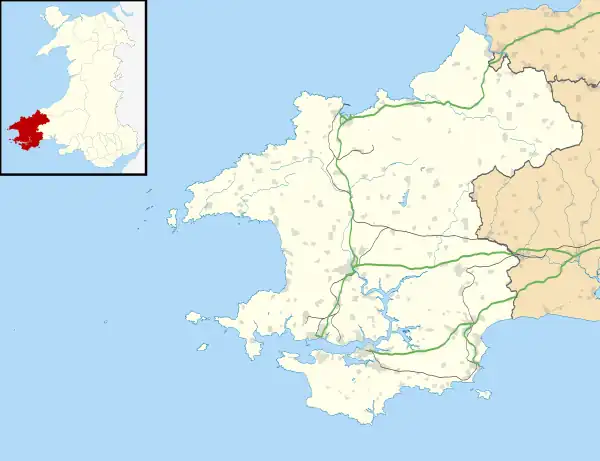Gumfreston
Gumfreston is a parish[1] and small village 1 mile (1.6 km) from St. Florence and 2 miles (3.2 km) from Tenby, south Pembrokeshire, Wales. It is in the community of St. Mary Out Liberty. The B4318 is the main road that passes through Gumfreston.
| Gumfreston | |
|---|---|
 Parish church of St Lawrence | |
 Gumfreston Location within Pembrokeshire | |
| Population | 103 |
| OS grid reference | SN109012 |
| Principal area | |
| Country | Wales |
| Sovereign state | United Kingdom |
| Police | Dyfed-Powys |
| Fire | Mid and West Wales |
| Ambulance | Welsh |
Parish
History
The parish appears on a 1578 parish map of Pembrokeshire.[2] There are a few houses in the village, but no other significant settlements in the mainly rural parish from a pre-1850 map.[3] In 1833 the parish was reported as having 103 inhabitants. Coal was worked on a small scale for local use.[1] The village is recorded as a historic place name by the Royal Commission in the early 20th century.[4] There are three named farms on modern maps: Daisy Back Farm, Glebe Farm and Gumfreston Farm, and a farm complex named North Astridge and South Astridge.[5]
Notable people
- William Wogan (1678–1758), born in Gumfreston, an Irish religious writer, sympathetic with early Methodism.[9]
References
- "GENUKI: Gumfreston". Retrieved 6 March 2016.
- "Penbrok comitat". British Library.
- "GENUKI Parish map 136". Retrieved 4 July 2020.
- "Royal Commission: Gumfreston". Retrieved 4 July 2020.
- "Ordnance Survey". Retrieved 4 July 2020.
- "A would-be nobleman has bought the title of Lord Wedlock for £2,000 at auction". Wales online. Retrieved 7 December 2016.
- "St Lawrence, Gumfreston". churchheritagecymru.org.uk. Retrieved 4 July 2020.
- "St Lawrence Church, Gumfreston". www.narberthtenbylma.co.uk. Retrieved 4 July 2020.
- Thomas, Daniel Lleufer (1900). . Dictionary of National Biography. Vol. 62. pp. 288–289.